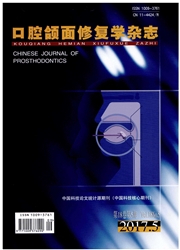

 中文摘要:
中文摘要:
目的:以BMP-2和地塞米松诱导的大鼠牙囊细胞作为种子细胞,β-磷酸三钙作为细胞支架材料,体外构建细胞生物材料复合体,观察大鼠牙囊细胞在β-磷酸三钙生物陶瓷材料的贴附、增殖情况。方法:收集培养的第3代RDFCs,血清饥饿同步化后,细胞分为四组,分别为BMP-2、Dex、BMP-2+Dex诱导组及空白对照组。诱导3d后,将密度为4×106/ml的细胞悬液0.1ml均匀接种到预制好的β-TCP支架材料上,分别于体外培养3d、7d取细胞材料复合体,通过细胞计数、扫描电子显微镜观察细胞在材料表面的贴附、增殖情况。结果:细胞计数发现,7d时BMP-2+Dex诱导组细胞数量显著高于BMP-2诱导组、Dex诱导组(P〈0.01)。扫描电镜观察,β-TCP表面呈多孔三维立体网状结构。细胞接种3 d和7d时,单位面积内BMP-2+Dex诱导组细胞数量均明显高于BMP-2诱导组、Dex诱导组、对照组。结论:β-磷酸三钙具有良好的生物相容性,利于大鼠牙囊细胞的贴附和生长,证明BMP-2和地塞米松联合作用促进大鼠牙囊细胞的增殖、分化的协同效应,为进一步使用BMP-2和地塞米松诱导大鼠牙囊细胞,并与β-磷酸三钙生物陶瓷复合后体内移植实验提供依据。
 英文摘要:
英文摘要:
Objective: To construct a three-dimensional culture model of RDFCs by using porous β-tricalcium phosphate(β-TCP) as scaffold and RDFCs as seed cells.To investigate the possibility and the biological capability of the reconstruction of the combined tissues by using RDFCs with β-TCP in vitro.Method: RDFCs of the third passage were induced by BMP-2(100ng/ml),Dex(10-8mol/ml) and a mixture of BMP-2(100ng/ml) and Dex(10-8mol/ml) in DMEM.After 3 days,the control cells were collected for combination with β-TCP scaffold and also cultured in DMEM solution.On the 3rd day and 7th day,RDFCs adhesion and growth were observed by scanning electronic microscope(SEM),the proliferation of the cells was evaluated by cell counting.Results: SEM showed that the multi-porus scaffold had 3 morphologically distinct pore types.The third passage rat dental follicle cells could be adhered and extended and proliferation on the β-TCP by SEM.Conclusion: The pours scaffold β-TCP had good 3-D structure and biocompatibility,which provided safe surface for RDFCs to adhere to and proliferate.It can be used as biomaterials in bone tissue engineering.
 同期刊论文项目
同期刊论文项目
 同项目期刊论文
同项目期刊论文
 期刊信息
期刊信息
